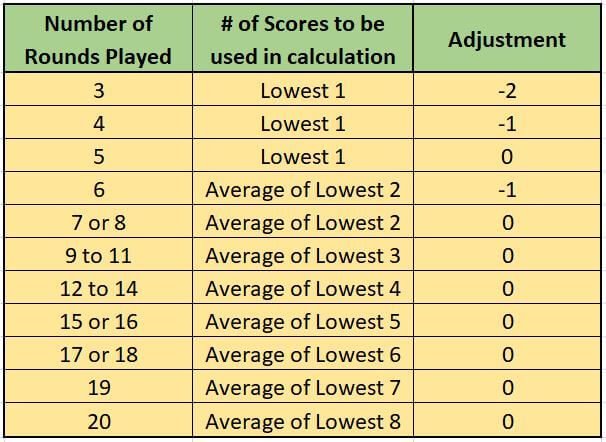Floating Chipping Greens – Top Pool or Lake Floating Golf Greens
Are you looking for an innovative way to practice your golf game this summer? Why not try a floating chipping green? Floating chipping greens are

The golf handicap is by far the most confusing thing to understand when you are just starting to begin golf. Handicaps are not very common and are only used in a few sports. So what exactly is the golf handicap? How do you calculate it? Why is it so important? These are questions new golfers will constantly ask. It is not always easy to get a straight answer to these questions. So we have created this short guide, discussing everything you need to understand and how to calculate golf handicap.
If you are new to this elite sport, it is extremely crucial to understand your handicap. Golf handicaps are represented by a number, indicating a golfer’s ability to perform based on the scores of their previous golf rounds. Knowing your golf handicap allows you to compare your performance with other players and determine what Course Handicap you require to play on a specific golf course.
Another reason you will need a golf handicap is that many organized tournaments require a USGA-approved handicap. In order to compete in these events, you need to have played and logged at least 3 rounds to have an established handicap. These rounds can be very competitive and fair. If you know how to calculate golf handicap, it will be much more advantageous for you.
Generally, handicaps for men is between 0 and 28, and for women, it is between 0 and 36.
Now that you know that understanding a golf handicap is essential, but the question is, how do you do it? Read on, and you will find everything there is to know about calculating a golf handicap. Let’s get started!
Golf handicap was introduced over a hundred years ago and has been used by golfers ever since. Previously, it was known among golfers as the ‘hands-on-cap.’ This used to involve three parties: two players and a referee. This term then changed to ‘golf handicap’ in 1850.
Presently, your golf handicap serves as a measuring scale that rates your abilities based on your previous golf scores compared to your course’s par round. Handicaps are used in both large and small tournaments and championships. From the gathering of your golfer friends to big club championships, you are likely to come across this term at every golf-related event.
Learn more about the evolution of the golf ball here.
If you have a handicap of 5, that means the average of your earlier golf rounds was 5 over par (this is based on the new criteria introduced in 2020). Typically, players calculate handicaps to analyze their performance compared to their average playing ability. Knowing your handicaps allows you to judge your performance and win against much better and competent players based on their level of play that day. In golf, players with a lower handicap are considered better. So, if your handicap score is 7 and your opponent’s 10, that means you are a better player
To obtain a handicap index, it is required that you submit at least 3 – 18-hole scores. This can be created from a mix of 18-hole and 9-hole golf rounds; the handicap index will be reviewed and revised on the 1st and 15th date of every month. The new criteria introduced in January 2020 require that you submit scores of only 18-hole golf rounds. Your handicap will be revised daily if you enter your three 18-hole round scores before midnight.
Learn more about inactive handicap vs active golf handicap here.
Golfers used to calculate their course handicap by considering and analyzing different golf elements. This is more of a manual process, but things have digitalized now. There are now several programs and applications available that can help you calculate your golf handicap in minutes. But if you are a little old schooled and want to try the old-fashioned ways, here is a simple formula to calculate a course handicap.
Some elements, including the calculation of golf handicap, are gross scores, slope rating, course handicap, index of the game, and others.
You can do this by using USGA’s equitable stroke control. You must use the ESC downwards and adjust the 18-hole score in order to obtain a golf handicap. ESC highlights that players are allowed only a maximum number of strokes they can hit in a single hole.
This keeps the playing field fair because the golfer who will shoot an 85 but have 1 “blow-up” hole with a 10 or higher stroke count, the handicap only allows that player to account for a 7 on that hole. It keeps people from purposefully raising their handicaps.
The table below shows the maximum number you can score on a hole given your current handicap.

Next, you need to calculate the handicap differential for each score. You can easily do this by using this formula:
Differential In Handicap = (Your score – Course Ratings) x 113/Course Slope.
Slope rating is based on the standard difficulty and is presented as a rating of 113 for a given course. While the course rating indicates the score of a player under normal conditions on a typical course.
You will now select the lowest scores based on the number of rounds you have played. If you have logged more than twenty rounds in the past rolling year, the top eight differentials of the twenty scores you have entered will become part of your calculation.
If you have not reached 20 rounds, the chart below shows the number of differentials you should take based on the number of rounds played.
Ex. If you have played 9-11 rounds, you will average your lowest 3 rounds. You are allowed an adjustment of -1 stroke if you have played 4 or 6 rounds. You are allowed an adjustment of -2 strokes for only playing 3 rounds.

The chart above reflects the updated 2023 USGA handicap rules. The 96% “Bonus for Excellence” was removed starting 1/1/2020 and the # of score differentials were updated.
Rounding off figures isn’t necessary. According to USGA, there is a standard maximum number in a golf match from any handicap index. This maximum number is 36.4 for men and 40.4 for women on an 18-hole golf course. While on a 9-hole golf course, this number changes to 20.2 for women and 18.2 for men.
For instance, if your average differential handicap is 14.196, it will become 14.1 after truncating. Do not round up or down for your handicap scores.
This step involves calculating your course handicap, which will be different for each course your play.
Use this formula to calculate the course handicap:
Course Handicap = Slope Rating x Your Handicap Index / (Course Rating – Par) + 113
With a course slope of 115 and a handicap index of 12.7, the calculation will look something like this:
Course Handicap = 115 x 12.7/113
Course Handicap = 12.92 = 13
The rules of calculating the handicap have varied from region to region with so many different systems in operation worldwide. To eliminate complications and incompatibilities, the governing bodies of this elite sport (R&A and USGA) decided to create a unified system. Working with existing golf authorities, they introduced a new World Handicap System (WHS) in January 2020. The changes in the system made it easier for golfers to calculate and compare handicaps.
Most golfers, especially the new ones, do not pay much attention to acquiring an accurate handicap. It can be very time-consuming. Without going through the long process of figuring out your handicap, we have created a chart for you. Based on the average score per 18 holes, you can estimate your golf handicap by following this guide:

In modern times, you can now download an app that will pretty much do all of the above for you. You should still understand how to calculate golf handicap even if you use one of these apps. The handicap rules are always being adjusted and not all apps will calculate the same. Here are some of our app favorites:
Since there is no official definition for low, mid, and high range handicaps, commonly accepted ranges among players may differ. Until the USGA and the R&A come out with official guidance, players typically follow an unwritten model. Taking that into consideration, it is widely accepted that the following scale is used:
Separating it into these ranges allows less experienced golfers a way to better understand their scores as they progress in the sport.
Aggregate scores were compiled to see the percentage of golfers that fall under the three main handicap ranges and the results were as followed:
Low Handicap: 21.42 percent of all golfers
Mid Handicap: 55.75 percent of all golfers
High Handicap: 22.93 percent of all golfers
These numbers appear to be contrary to what the VGA reports, considering they released that 45 percent of all golfers score over 100. This contributes to the notion that aggregate scoring sites are not incredibly reliable. They do give you a mild glimpse into the world of golf scores but don’t let that discourage you if you have a higher handicap. You may be among average golfers, or even better than that, and not even be aware of it.
Improve your golf handicap with these best chipping drills for beginners.
Your handicap is a barometer that indicates how efficient a player you are. It is essential to both learn to calculate and improve your handicap if you want to go far ahead in the game.
If you are new to golf and have never played a round in your life, then you clearly have no handicap. When you start playing golf, the first thing you should do is keep track of your 18 and 9-hole scores using a golf scorecard holder. Record your scores on a scorecard and log it into some kind of app. The more scores you log, the better chance you have of improving your handicap.
Categories
Are you looking for an innovative way to practice your golf game this summer? Why not try a floating chipping green? Floating chipping greens are
Instructional Video Coming Soon
How I got on hole 16 (The Stadium hole) at the Waste Management Phoenix Open with little to no wait!! I also have tips and tricks on what to do once you are inside the gate and inside the stadium hole. Check this out if you ever plan to make a trip out! If you ever have the chance, it is definitely worth the trip.